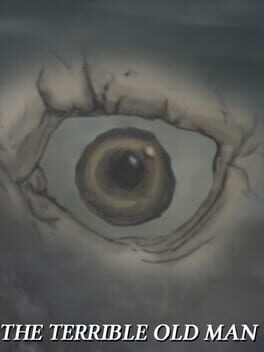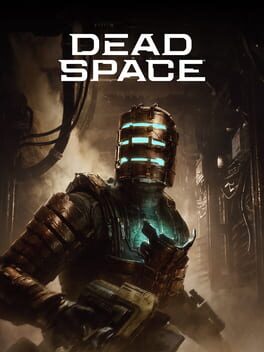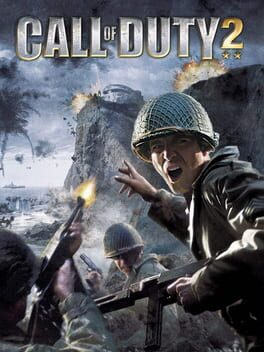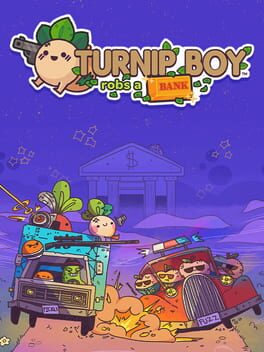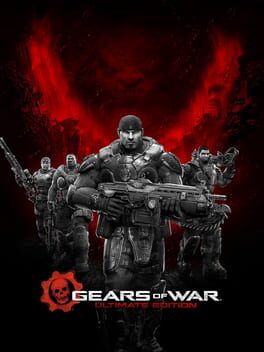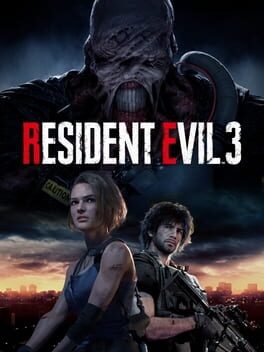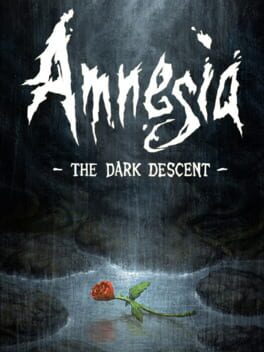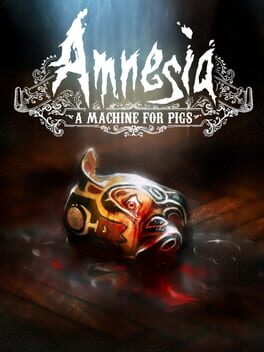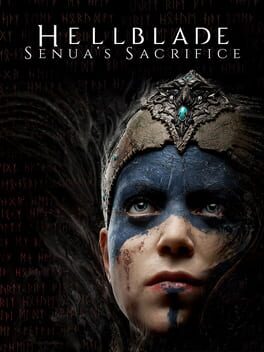szymon
2021
2015
2016
Man, I really wish I could give it a positive review, because this is clearly a labor of love. The score is very effective, oftentimes reminding me of big budget Hollywood espionage thrillers. The art style is minimalist, akin to ‘Firewatch’, but I liked it, even though some larger areas could’ve used some more ‘clutter’ to make them feel more lived in and not like empty sets. The character animations are very simple, but I felt they were usually effective in conveying the emotions of NPCs.
‘Virginia’ goes for the cinematic experience with very little interactivity available to the player. You’ll be mostly jumping from one short scene to another, observing events unfold in front of you. Sometimes you’ll be able to roam around a room or an apartment in search of an object to click on to move the plot further. Unlike in most walking simulators, you don’t have the opportunity to explore and interact with a variety of objects or documents that would help you fill in the gaps in the story - here you’re basically just shown 90 minutes or so of vague cutscenes (there is no dialogue in the game).
Understanding the story is one thing (mostly doable on your first playthrough, although some story beats could’ve been presented in a better way), but caring about the characters is a completely different issue. Towards the end of the experience the devs clearly wanted to elicit some emotional response from me, but they failed miserably as I was given almost nothing to make me form any attachment to any of the characters. This is where the game suffers most from its extremely minimalist approach.
‘Virginia’ goes for the cinematic experience with very little interactivity available to the player. You’ll be mostly jumping from one short scene to another, observing events unfold in front of you. Sometimes you’ll be able to roam around a room or an apartment in search of an object to click on to move the plot further. Unlike in most walking simulators, you don’t have the opportunity to explore and interact with a variety of objects or documents that would help you fill in the gaps in the story - here you’re basically just shown 90 minutes or so of vague cutscenes (there is no dialogue in the game).
Understanding the story is one thing (mostly doable on your first playthrough, although some story beats could’ve been presented in a better way), but caring about the characters is a completely different issue. Towards the end of the experience the devs clearly wanted to elicit some emotional response from me, but they failed miserably as I was given almost nothing to make me form any attachment to any of the characters. This is where the game suffers most from its extremely minimalist approach.
2023
Would I rather EA had greenlit a brand new entry in the franchise? Of course. Did the original age enough to warrant a full remake? I don’t think so, no - I played it for the very first time 3 years ago and it was still superbly playable. But did I enjoy my time with this remake? Absolutely.
The new graphics are very impressive, with the enemy designs looking more gruesome than ever. The haunting atmosphere and palpable feeling of danger lurking just around the corner are still very much present and make traversing Ishimura a harrowing experience, perhaps just a little too easy, even on the Hard difficulty (yeah, I’m not risking hours of progress on the Impossible setting, thanks). The dismemberment mechanic is satisfying as ever and the available array of weapons and tools make combat both tense and fun.
Sure, there are some nitpicks here and there - the zero gravity movement is still wonky, turning Isaac into a voiced protagonist doesn’t work well since he’s not interesting a character at all, and the final battle is kind of meh. But as I said, these are nitpicks and the overall experience is still highly recommended, in all of its 12 hours of slashing through some of the most hideous monsters in survival horror history (plus some really interesting lore!) glory.
The new graphics are very impressive, with the enemy designs looking more gruesome than ever. The haunting atmosphere and palpable feeling of danger lurking just around the corner are still very much present and make traversing Ishimura a harrowing experience, perhaps just a little too easy, even on the Hard difficulty (yeah, I’m not risking hours of progress on the Impossible setting, thanks). The dismemberment mechanic is satisfying as ever and the available array of weapons and tools make combat both tense and fun.
Sure, there are some nitpicks here and there - the zero gravity movement is still wonky, turning Isaac into a voiced protagonist doesn’t work well since he’s not interesting a character at all, and the final battle is kind of meh. But as I said, these are nitpicks and the overall experience is still highly recommended, in all of its 12 hours of slashing through some of the most hideous monsters in survival horror history (plus some really interesting lore!) glory.
2005
I remember playing Call of Duty 2 right after it came out and the immense impact it had on me. I’m not sure how many times I started the campaign (never cared much for the multiplayer), but I definitely spent most time in snow covered Stalingrad, mowing down hundreds of Nazis. I can still quote word for word the training Vassilyi receives from Comrade Commissar. I also remember having to quit the game to cool down after clearing the German hideouts in one of the missions in North Africa - that’s how powerful the experience was for me back then. And recently, after going through my Steam library looking for something to play, I stumbled upon this oldie and thought I could give it a go, all these years later.
Alas, some childhood experiences are not meant to be repeated in adulthood. The second installment in one of the biggest gaming franchises in history did not age gracefully. And I’m not even talking about the graphics, although naturally they show their age. The character models hold up pretty well and some of the animations still look decent. The main problem is the levels - most of them look drab and empty, and it’s sometimes difficult to spot any differences in levels across the same campaign - all levels in Stalingrad look alike, same with the deserts of Libya or the villages in France. This is a serious problem that made me feel like I was replaying the same level over and over again until I got to the next campaign.
What exacerbates this feeling of running in circles is mission structure. Throughout all three campaigns - Soviet, American and British - the player is usually given the task of clearing houses/bunkers/fields/whatever of German troops and moving to the next location where he’ll be doing the exact same thing. Sure, there are some variations - shooting down a tank, sniping enemies from a high vantage point, a (very underwhelming) tank battle or some on-rails vehicle sections (which would become a series staple in further installments), but they are mere drops in a sea of mundanity. Yes, the shooting is still quite fun and the weapons feel fine (although I think they could’ve used some more variety), but repetitiveness is still the defining factor of most levels.
What I found most frustrating is the AI on both sides of the conflict. Enemies tend to run out of cover for no good reason and sometimes spawn right behind your back, just when you thought you had cleared the area. Your brothers in arms are even worse, unfortunately. They love to get right in your line of fire, they block hallways and stand on German grenades, waiting for them to explode and end their short lives. I also witnessed the legendary Captain Price throw a grenade right into the wall in front of him and the thing ricocheting back to one of his soldiers, who patiently waited to be blown to pieces (by the way, the game could do with fewer grenades available to your enemies, on Hard difficulty especially, as on some levels I felt like I did more running away from grenades than actual shooting, and in this game you can’t throw them back yet).
And when your companions and enemies meet, miracles happen. There were so many instances of German and Allied soldiers standing right next to each other and not acknowledging each other’s presence simply because the AI was focused on enemies tens of meters away. This obviously kills any sense of immersion, where you’re thrown into an environment where you’re supposed to be fighting for your life but every minute you stumble upon soldiers so stupid you just stop and look in sincere admiration instead. These moments kill the feeling the game tries to create - of facing overwhelming Nazi forces, fighting side by side with your compatriots. Instead, the faulty AI made me feel like I was the only human amongst malfunctioning robots.
There are some interesting ideas regarding AI, e.g. your brothers in arms will often shout the current location of enemy soldiers. This would be useful in a game with more open levels, because apart from some specific scenarios where enemies approach you from all sides this was rather superfluous. On that topic - yes, I realize it’s Call of Duty and it’s expected to be linear, but I felt like some levels were too limiting in where I was allowed to go. There are some levels with opportunities for flanking for example, but there is also a large number of corridors where you’re just supposed to face the enemy head on.
There are some truly amazing moments and I’d like to make it clear. Taking down the first tank in Stalingrad, landing on the beaches of Normandy (yes, ripped straight from ‘Saving Private Ryan’, but still pretty effective), the first level clearing Nazi bunkers in North Africa. But they’re few and far between, and the vast majority of the game is a pretty run of the mill World War 2 era FPS. I found out rather quickly that the game is quite tedious in longer sittings and works best in short, no more than 30 minute sessions.
One quick note - I was taken aback by the choice of quotes that are shown on screen when I died or reached a new level. The game clearly tries to romanticize the conflict it portrays - the score full of pathos, the Hollywood-like last minute rescues, the over the top voice acting (the British sound like caricatures), or the soldiers that are always eager to jump into action to ‘take down some Krauts’ and never express any fear or discomfort. The only level that might be considered an attempt to emulate ‘real’ (very thick quotation marks here) experience is the Normandy landing with its well directed introduction and incessant, deafening artillery strikes (although that might just be the Spielberg influence). Other than that it’s a pretty clean, inoffensive, ‘Greatest Generation casually killing Jerries’ type of narrative that doesn’t have absolutely anything to say. Why the odd choice of quotes, then? There are plenty of examples of lines harshly criticizing war and lamenting the loss of life, which are in stark contrast to the actual game which makes war look fun. Also, I wonder how some historical figures who said those quotes, e.g. Churchill and Zapata, would feel about being placed next to each other. Perhaps I’m reading too much into this and the developers simply looked up ‘quotes about war’, chose some that they thought sounded cool and never thought about it again. All in all, I think that the following Erasmus quote sums up the whole experience and at the same time it’s extremely ironic for having been included in this particular game: "War is delightful to those who have not experienced it."
Alas, some childhood experiences are not meant to be repeated in adulthood. The second installment in one of the biggest gaming franchises in history did not age gracefully. And I’m not even talking about the graphics, although naturally they show their age. The character models hold up pretty well and some of the animations still look decent. The main problem is the levels - most of them look drab and empty, and it’s sometimes difficult to spot any differences in levels across the same campaign - all levels in Stalingrad look alike, same with the deserts of Libya or the villages in France. This is a serious problem that made me feel like I was replaying the same level over and over again until I got to the next campaign.
What exacerbates this feeling of running in circles is mission structure. Throughout all three campaigns - Soviet, American and British - the player is usually given the task of clearing houses/bunkers/fields/whatever of German troops and moving to the next location where he’ll be doing the exact same thing. Sure, there are some variations - shooting down a tank, sniping enemies from a high vantage point, a (very underwhelming) tank battle or some on-rails vehicle sections (which would become a series staple in further installments), but they are mere drops in a sea of mundanity. Yes, the shooting is still quite fun and the weapons feel fine (although I think they could’ve used some more variety), but repetitiveness is still the defining factor of most levels.
What I found most frustrating is the AI on both sides of the conflict. Enemies tend to run out of cover for no good reason and sometimes spawn right behind your back, just when you thought you had cleared the area. Your brothers in arms are even worse, unfortunately. They love to get right in your line of fire, they block hallways and stand on German grenades, waiting for them to explode and end their short lives. I also witnessed the legendary Captain Price throw a grenade right into the wall in front of him and the thing ricocheting back to one of his soldiers, who patiently waited to be blown to pieces (by the way, the game could do with fewer grenades available to your enemies, on Hard difficulty especially, as on some levels I felt like I did more running away from grenades than actual shooting, and in this game you can’t throw them back yet).
And when your companions and enemies meet, miracles happen. There were so many instances of German and Allied soldiers standing right next to each other and not acknowledging each other’s presence simply because the AI was focused on enemies tens of meters away. This obviously kills any sense of immersion, where you’re thrown into an environment where you’re supposed to be fighting for your life but every minute you stumble upon soldiers so stupid you just stop and look in sincere admiration instead. These moments kill the feeling the game tries to create - of facing overwhelming Nazi forces, fighting side by side with your compatriots. Instead, the faulty AI made me feel like I was the only human amongst malfunctioning robots.
There are some interesting ideas regarding AI, e.g. your brothers in arms will often shout the current location of enemy soldiers. This would be useful in a game with more open levels, because apart from some specific scenarios where enemies approach you from all sides this was rather superfluous. On that topic - yes, I realize it’s Call of Duty and it’s expected to be linear, but I felt like some levels were too limiting in where I was allowed to go. There are some levels with opportunities for flanking for example, but there is also a large number of corridors where you’re just supposed to face the enemy head on.
There are some truly amazing moments and I’d like to make it clear. Taking down the first tank in Stalingrad, landing on the beaches of Normandy (yes, ripped straight from ‘Saving Private Ryan’, but still pretty effective), the first level clearing Nazi bunkers in North Africa. But they’re few and far between, and the vast majority of the game is a pretty run of the mill World War 2 era FPS. I found out rather quickly that the game is quite tedious in longer sittings and works best in short, no more than 30 minute sessions.
One quick note - I was taken aback by the choice of quotes that are shown on screen when I died or reached a new level. The game clearly tries to romanticize the conflict it portrays - the score full of pathos, the Hollywood-like last minute rescues, the over the top voice acting (the British sound like caricatures), or the soldiers that are always eager to jump into action to ‘take down some Krauts’ and never express any fear or discomfort. The only level that might be considered an attempt to emulate ‘real’ (very thick quotation marks here) experience is the Normandy landing with its well directed introduction and incessant, deafening artillery strikes (although that might just be the Spielberg influence). Other than that it’s a pretty clean, inoffensive, ‘Greatest Generation casually killing Jerries’ type of narrative that doesn’t have absolutely anything to say. Why the odd choice of quotes, then? There are plenty of examples of lines harshly criticizing war and lamenting the loss of life, which are in stark contrast to the actual game which makes war look fun. Also, I wonder how some historical figures who said those quotes, e.g. Churchill and Zapata, would feel about being placed next to each other. Perhaps I’m reading too much into this and the developers simply looked up ‘quotes about war’, chose some that they thought sounded cool and never thought about it again. All in all, I think that the following Erasmus quote sums up the whole experience and at the same time it’s extremely ironic for having been included in this particular game: "War is delightful to those who have not experienced it."
I think it’s safe to say that 2021’s “Turnip Boy Commits Tax Evasion” caught everyone by surprise by blending competent 2D Zelda-like gameplay with quirky, plant-based humor and a pleasant visual style. I enjoyed it quite a bit and was looking forward to its sequel. And I was caught by surprise yet again, because it turned out that the devs decided to switch the genre from an old-school adventure game to a roguelite mixed with bullet hell. Unfortunately, it doesn’t work as well as the original.
I’ll be the first to admit that I’m not a fan of roguelites, and this is no exception. Running over and over through the same couple of areas and mowing down the same enemies gets old really quick for me, and Turnip Boy doesn’t provide enough scope or variety to make traversing through the map a truly enjoyable experience. Most of my time playing the game was searching for NPCs that I had an outstanding quest with - there are a lot of characters you can help throughout the 5 hours or so that it takes to finish the story. Honestly, I mostly walked aimlessly searching for an NPC whose location I had completely forgotten (the map is utterly useless) or simply because I had confused one NPC with another. This can be frustrating not only because there is no good way to memorize this (and some NPCs only show up in rooms that spawn at random, so you can be looking for a guy and never stumble upon him simply because his room didn’t spawn for this particular run), but also because you’re always under a time constraint. At one point I found myself with a long list of NPCs to interact with, a map that doesn’t help at all in finding them and a thought “yeah, I don’t remember where any of those characters are”.
Perhaps this problem is exacerbated by the writing. The trademark quirkiness is still there and some NPCs’ lines should make you smile, but either the novelty factor has worn off or the writing simply isn’t as sharp because I found the NPCs in “Tax Evasion” funnier, more memorable and their plotlines easier to follow than the ones in “Robs a Bank”.
Overall, I enjoyed the gunplay - I think there is a good selection of weapons available (a lot of them, obviously, are very comedic in nature) and they’re fun to use, but the fact that you can’t really store them conveniently (there’s one particular room where you can keep them for your next run, but it’s an extremely tedious mechanic) and that the only weapons that you have permanent access to in your hub are the most standard shotgun/rifle/bazooka spoils the fun of trying out new weapons.
Two other issues I’d like to mention are underwhelming boss fights (they’re all very similar and at the very end you have to repeat them all in one go, which is a chore) and the fact that about halfway through the game you find a way to earn tons of cash quickly and run out of things you can spend them on. I think the upgrade system could’ve been expanded to account for that.
I’ll be the first to admit that I’m not a fan of roguelites, and this is no exception. Running over and over through the same couple of areas and mowing down the same enemies gets old really quick for me, and Turnip Boy doesn’t provide enough scope or variety to make traversing through the map a truly enjoyable experience. Most of my time playing the game was searching for NPCs that I had an outstanding quest with - there are a lot of characters you can help throughout the 5 hours or so that it takes to finish the story. Honestly, I mostly walked aimlessly searching for an NPC whose location I had completely forgotten (the map is utterly useless) or simply because I had confused one NPC with another. This can be frustrating not only because there is no good way to memorize this (and some NPCs only show up in rooms that spawn at random, so you can be looking for a guy and never stumble upon him simply because his room didn’t spawn for this particular run), but also because you’re always under a time constraint. At one point I found myself with a long list of NPCs to interact with, a map that doesn’t help at all in finding them and a thought “yeah, I don’t remember where any of those characters are”.
Perhaps this problem is exacerbated by the writing. The trademark quirkiness is still there and some NPCs’ lines should make you smile, but either the novelty factor has worn off or the writing simply isn’t as sharp because I found the NPCs in “Tax Evasion” funnier, more memorable and their plotlines easier to follow than the ones in “Robs a Bank”.
Overall, I enjoyed the gunplay - I think there is a good selection of weapons available (a lot of them, obviously, are very comedic in nature) and they’re fun to use, but the fact that you can’t really store them conveniently (there’s one particular room where you can keep them for your next run, but it’s an extremely tedious mechanic) and that the only weapons that you have permanent access to in your hub are the most standard shotgun/rifle/bazooka spoils the fun of trying out new weapons.
Two other issues I’d like to mention are underwhelming boss fights (they’re all very similar and at the very end you have to repeat them all in one go, which is a chore) and the fact that about halfway through the game you find a way to earn tons of cash quickly and run out of things you can spend them on. I think the upgrade system could’ve been expanded to account for that.
2019
Damn, this game still looks exquisite. The environments, the animations, the character models, the lighting - all perfect. Wanted to get it out of the way first since when I think of the Resi 2 remake I always remember the gameplay trailer reveal and the jaw-drop effect it had on me. Still does!
When it comes to the gameplay, I think it’s enough to call it a proper Resident Evil-type game. Walking around a large area, using your map frequently to check whether you’ve cleared each room (the map can sometimes be confusing, though, mostly involving staircases), solving puzzles (simple but sufficient for this type of game), managing your inventory and occasionally shooting down a zombie or two when they get in your way. The devs really pulled all the best bits from the original entries and modernized it to accommodate for the third person view and larger levels. Overall, it is a very satisfying experience, although the definite highlight is the police station and the weakest link are the sewers. Mr. X adds some tension, stomping around and making you check every corner twice, although he can be a nuisance sometimes, e.g. when he takes forever to leave the area of the safe room you are hiding in.
The story is extremely cheesy, but serviceable. Both Leon and Claire are likable, although the male protagonist is a total airhead whose lines and decisions had me rolling my eyes a number of times. The short interludes where you control Ada (Leon’s playthrough) and Sherry (Claire’s) are a nice way to break up the main gameplay loop and introduce some fresh gameplay elements.
What brings down the game’s quality significantly in my eyes is its treatment of the two campaigns. Leon’s and Claire’s stories are supposed to intertwine, but after finishing off Mr. X with the R.P.D. cop I found that I had to redo most of the puzzles and open the same doors again, this time controlling Chris Redfield’s sister. Narratively, it just doesn’t make any sense. Sure, some key items can be found in different places and you can get key A instead of key B to open a different room with some helpful item, but overall it felt like a chore. Since I knew where to go and what to do, playing as Claire felt more mechanical rather than truly exploring each of the main areas. I really did suffer through the second playthrough, save for the few levels that were unique to her. I treat these two campaigns as equally important to the game - after all, finishing them both is required to achieve the true ending - and I think that the devs could’ve come up with some new areas or puzzles for the second playthrough. Even the boss fights are repeated (except for the final one), which was a major letdown.
Overall, this is a very good experience for the first playthrough, whoever you choose, but then the second one is just a rehash that will probably make you try to speedrun to get to the proper ending.
When it comes to the gameplay, I think it’s enough to call it a proper Resident Evil-type game. Walking around a large area, using your map frequently to check whether you’ve cleared each room (the map can sometimes be confusing, though, mostly involving staircases), solving puzzles (simple but sufficient for this type of game), managing your inventory and occasionally shooting down a zombie or two when they get in your way. The devs really pulled all the best bits from the original entries and modernized it to accommodate for the third person view and larger levels. Overall, it is a very satisfying experience, although the definite highlight is the police station and the weakest link are the sewers. Mr. X adds some tension, stomping around and making you check every corner twice, although he can be a nuisance sometimes, e.g. when he takes forever to leave the area of the safe room you are hiding in.
The story is extremely cheesy, but serviceable. Both Leon and Claire are likable, although the male protagonist is a total airhead whose lines and decisions had me rolling my eyes a number of times. The short interludes where you control Ada (Leon’s playthrough) and Sherry (Claire’s) are a nice way to break up the main gameplay loop and introduce some fresh gameplay elements.
What brings down the game’s quality significantly in my eyes is its treatment of the two campaigns. Leon’s and Claire’s stories are supposed to intertwine, but after finishing off Mr. X with the R.P.D. cop I found that I had to redo most of the puzzles and open the same doors again, this time controlling Chris Redfield’s sister. Narratively, it just doesn’t make any sense. Sure, some key items can be found in different places and you can get key A instead of key B to open a different room with some helpful item, but overall it felt like a chore. Since I knew where to go and what to do, playing as Claire felt more mechanical rather than truly exploring each of the main areas. I really did suffer through the second playthrough, save for the few levels that were unique to her. I treat these two campaigns as equally important to the game - after all, finishing them both is required to achieve the true ending - and I think that the devs could’ve come up with some new areas or puzzles for the second playthrough. Even the boss fights are repeated (except for the final one), which was a major letdown.
Overall, this is a very good experience for the first playthrough, whoever you choose, but then the second one is just a rehash that will probably make you try to speedrun to get to the proper ending.
2023
‘Planet of Lana’ is a 2D, narrative-driven puzzle platformer that reminded me heavily of Playdead’s most famous game, ‘Inside’. The core of the title is running (mostly) right, solving puzzles, evading enemies and learning about the world through environmental storytelling. The main difference, other than lack of oppressive atmosphere and inclusion of a more pleasant color palette, is that in Wishfully Studios’ debut game you are able to give commands to a tiny cat-like creature, Mui. This adds some flavor to the puzzles, although unfortunately most of them are much too easy to force you to rack your brain or to stay in your memory after you’ve solved them. The mechanic of ordering your animal companion around is underutilized, same with controlling hostile robots. I feel like there was potential for more complex and memorable puzzles, but as I’m writing this review - roughly a week after finishing the game - I struggle to remember any particular moments or set pieces other than the wind turbine section, mostly because that was the only place where I died several times.
The visual style is on the minimalist side, but that’s perfectly fine in a game of this type and scope. I liked the lively colors of the forest and the final chapter introduces some surprising backgrounds, although they could’ve used more variety and at least a little bit more detail to make each particular level more visually interesting. Storywise, the game only gives clues as to the nature of the events unfolding before our eyes, but it is told competently and welcomes various interpretations. Also, I liked the simple yet effective way the devs build the relationship between the titular character and her ‘pet’, Mui.
The controls feel a little sluggish, which also reminded me of some more famous narrative platformers. There aren’t too many places where it bothered me, though, as only in a few instances the game forces you to be perfect with your timing, although I did struggle with the flying sections as the controls were definitely too floaty and caused me to bump into obstacles and die a number of times.
Reading the previous paragraphs I feel like I’m complaining a lot, but I want to emphasize that the game isn’t bad by any means. It simply felt like it was a little too plain, perhaps too safe (understandable given this is the studio’s first game), but I definitely see potential and hope that future games by Wishfully Studios will take some more risks to differentiate themselves from other representatives of the genre. And drop the QTEs!
The visual style is on the minimalist side, but that’s perfectly fine in a game of this type and scope. I liked the lively colors of the forest and the final chapter introduces some surprising backgrounds, although they could’ve used more variety and at least a little bit more detail to make each particular level more visually interesting. Storywise, the game only gives clues as to the nature of the events unfolding before our eyes, but it is told competently and welcomes various interpretations. Also, I liked the simple yet effective way the devs build the relationship between the titular character and her ‘pet’, Mui.
The controls feel a little sluggish, which also reminded me of some more famous narrative platformers. There aren’t too many places where it bothered me, though, as only in a few instances the game forces you to be perfect with your timing, although I did struggle with the flying sections as the controls were definitely too floaty and caused me to bump into obstacles and die a number of times.
Reading the previous paragraphs I feel like I’m complaining a lot, but I want to emphasize that the game isn’t bad by any means. It simply felt like it was a little too plain, perhaps too safe (understandable given this is the studio’s first game), but I definitely see potential and hope that future games by Wishfully Studios will take some more risks to differentiate themselves from other representatives of the genre. And drop the QTEs!
2019
A delicious little gem that offers a pleasant area to explore, some simple puzzles to solve and a cast of funny, well-written characters. The only real nitpick I have is that the fixed camera angles can sometimes be detrimental to exploration (would’ve been great to include some sort of a zoom out option to see a larger part of the area), same goes for landing Claire in a particular spot. Other than that, a very calming, enjoyable experience.
A game that has been discussed to death, so I’ll try to keep this brief. Yes, the cover-based shooting (and reloading!) mechanics are still very much enjoyable. The story and world building are simple yet effective (I was surprised at how likable the characters are, even though they ooze early 2000’s macho energy including Marcus’ soul patch, Jesus Christ), the berserker sections are usually tense (although her AI can sometimes break), the weapons are very satisfying to use. To anyone who has missed this game for whatever reason, I still very much recommend giving it a try, not just as a milestone in game development history, but simply as a fun gaming experience.
I did, however, encounter a number of issues that I’m going to list below that prevented me from enjoying the game to the fullest. Bear in mind I was playing solo on hardcore difficulty, perhaps these issues are not as prevalent in other configurations:
sprinting is just plain bad - it takes forever between pressing the button and Marcus beginning to run;
it’s difficult to move your character around quickly - not an issue when you’re behind cover far from enemies, but when you find yourself amongst them there’s a low probability you will get out of the situation alive;
assigning sprinting, ducking behind cover and rolling to the same button should be a criminal offense;
some sections, like driving the junker, were clearly designed for co-op play - switching between the UV light and driving is extremely cumbersome;
AI of your companions turns them into morons that will jump out of cover and charge the enemy, getting shot and rendering himself useless - I am NOT leaving cover to pick you up from the middle of the battlefield (yes, I know you can give your companions simple commands, but when you don’t use them at all the AI should be able to exhibit some sensibility and at least shoot from behind cover);
using chainsaw is extremely unreliable, I died countless times just because the game didn’t think I was worthy of revving the engine for whatever reason, leaving me standing next to an enemy like a total idiot;
torque bow enemies, good God, I can’t recall the last time I was so annoyed by an enemy in a TPS;
the final boss design is simply lazy and disappointing.
I did, however, encounter a number of issues that I’m going to list below that prevented me from enjoying the game to the fullest. Bear in mind I was playing solo on hardcore difficulty, perhaps these issues are not as prevalent in other configurations:
sprinting is just plain bad - it takes forever between pressing the button and Marcus beginning to run;
it’s difficult to move your character around quickly - not an issue when you’re behind cover far from enemies, but when you find yourself amongst them there’s a low probability you will get out of the situation alive;
assigning sprinting, ducking behind cover and rolling to the same button should be a criminal offense;
some sections, like driving the junker, were clearly designed for co-op play - switching between the UV light and driving is extremely cumbersome;
AI of your companions turns them into morons that will jump out of cover and charge the enemy, getting shot and rendering himself useless - I am NOT leaving cover to pick you up from the middle of the battlefield (yes, I know you can give your companions simple commands, but when you don’t use them at all the AI should be able to exhibit some sensibility and at least shoot from behind cover);
using chainsaw is extremely unreliable, I died countless times just because the game didn’t think I was worthy of revving the engine for whatever reason, leaving me standing next to an enemy like a total idiot;
torque bow enemies, good God, I can’t recall the last time I was so annoyed by an enemy in a TPS;
the final boss design is simply lazy and disappointing.
2020
Yeah, so… what happened? Don’t get me wrong, I never played the original Resi trilogy so I have no idea how faithful the remakes are, but the difference in game philosophy between RE2 and RE3 is staggering. After a game focused on meticulous clearing of each room and careful inventory management we get a game stripped of almost everything that made the previous entry in the franchise so fun to play.
The tension is almost entirely gone, maybe except for the first hour where you’re navigating around a sizable chunk of Raccoon City and, in proper RE fashion, need to find a handful of key objects to access the next level. The city looks gorgeous, both the street exteriors and shop interiors are packed with details that bring the city to life. But even in these first moments with the game it feels like a watered down version of RE2.
The game pushes you quickly from one area to the next without too much backtracking, which in theory should sound like an improvement, but the whole idea of the predecessor was learning the layout of the level and trying to survive amongst zombies which were difficult to put down for good and with Mr. X breathing down your neck. This time the experience is closer to a run of the mill action game with competent shooting mechanics and impressive visuals, but very little soul or tension left. And yes, Nemesis is an absolute chore to fight.
Lastly - it took me 4 hours to beat the game, almost to the minute. For a title with no replayability value it’s almost criminal to sell the game at full price, thankfully I got to play it through Game Pass. But the cut scenes look nice, maybe that’s where the budget went? Anyway, Resident Evil 3 is completely skippable.
The tension is almost entirely gone, maybe except for the first hour where you’re navigating around a sizable chunk of Raccoon City and, in proper RE fashion, need to find a handful of key objects to access the next level. The city looks gorgeous, both the street exteriors and shop interiors are packed with details that bring the city to life. But even in these first moments with the game it feels like a watered down version of RE2.
The game pushes you quickly from one area to the next without too much backtracking, which in theory should sound like an improvement, but the whole idea of the predecessor was learning the layout of the level and trying to survive amongst zombies which were difficult to put down for good and with Mr. X breathing down your neck. This time the experience is closer to a run of the mill action game with competent shooting mechanics and impressive visuals, but very little soul or tension left. And yes, Nemesis is an absolute chore to fight.
Lastly - it took me 4 hours to beat the game, almost to the minute. For a title with no replayability value it’s almost criminal to sell the game at full price, thankfully I got to play it through Game Pass. But the cut scenes look nice, maybe that’s where the budget went? Anyway, Resident Evil 3 is completely skippable.
The thing I appreciate the most about this collection of three games in the Frog Detective franchise is being able to see how the games got bigger and more nuanced with each entry (in the last one you even get a scooter to drive around). The core of the gameplay is the same - you talk to NPCs, each of them needs an item from you and in return will reward you with another item that some other character requires, and so on. It’s a very simple loop, but it works because of the writing - it’s very quirky, with lots of pleasant, PG humor and colorful characters. You even get to decorate your own detective notebook, which comes in handy in second and third entries as the number of characters you need to help increases.
Going forward (no idea if the devs are planning to continue with the franchise, but anyway) I’d love to see some actual puzzles in the game, which would break up the loop of simply walking from one NPC to another and exchanging key items.
There’s also a Tony Hawks’ Pro Skater-like minigame involving a scooter, but I found the controls to be too wonky to enjoy it.
Going forward (no idea if the devs are planning to continue with the franchise, but anyway) I’d love to see some actual puzzles in the game, which would break up the loop of simply walking from one NPC to another and exchanging key items.
There’s also a Tony Hawks’ Pro Skater-like minigame involving a scooter, but I found the controls to be too wonky to enjoy it.
I can’t believe it took me almost 15 years to play the ‘scariest game of all time’ that kickstarted the careers of countless YouTube let’s players. Thankfully, ‘Amnesia’ turned out to be much, much more than a cheap jumpscare fest that spawned tons of mediocre “you can’t fight back” horror games after its initial wave of success.
I love the pacing of the game. You’re given enough time to breathe and relax (?) between the properly stressful parts to sustain the player’s interest for the 8 hours or it takes to reach the final credits. The enemies (that you can’t fight, naturally) are used wisely and don’t jump at you at every corner, rather creep in the darkness around maze-like levels, making you fear they might be lurking behind every corner. This really heightens the tension, and even after figuring out what triggers and what breaks enemy AI and using this information to your advantage they remain scary opponents rather than annoying obstacles to run past.
Not unlike many representatives of the survival horror genre, here you also have to manage your resources, although rather than bullets and grenades they are access to light (lamp oil and tinderboxes) and sanity. Even on normal difficulty (recommended by the devs) on occasion I would run out of lamp oil and would have to desperately wander around the level in search of a container, with Daniel panting loudly and quickly losing his grasp on reality, which is expressed by the changing, wavy visuals.
The game’s greatest strength - next to the wonderful atmosphere, interesting puzzles and clever level design - is the story. I was genuinely eager to find the next note that would provide some more backstory for Daniel and Alexander of Brennenberg. The lore is quite rich and the consecutive revelations regarding Daniel’s role in the castle made me increasingly uneasy about controlling this particular character, which is not a wholly original trope in the world of horror stories in general, but it was executed quite well in ‘Amnesia’.
The game is ugly as sin, but that exacerbates the oppressiveness of the environments and increases the likelihood of getting lost, further increasing the stress levels (I never thought it reached the point of annoyance, though). The sound design is exquisite, always keeping you on your toes.
I love the pacing of the game. You’re given enough time to breathe and relax (?) between the properly stressful parts to sustain the player’s interest for the 8 hours or it takes to reach the final credits. The enemies (that you can’t fight, naturally) are used wisely and don’t jump at you at every corner, rather creep in the darkness around maze-like levels, making you fear they might be lurking behind every corner. This really heightens the tension, and even after figuring out what triggers and what breaks enemy AI and using this information to your advantage they remain scary opponents rather than annoying obstacles to run past.
Not unlike many representatives of the survival horror genre, here you also have to manage your resources, although rather than bullets and grenades they are access to light (lamp oil and tinderboxes) and sanity. Even on normal difficulty (recommended by the devs) on occasion I would run out of lamp oil and would have to desperately wander around the level in search of a container, with Daniel panting loudly and quickly losing his grasp on reality, which is expressed by the changing, wavy visuals.
The game’s greatest strength - next to the wonderful atmosphere, interesting puzzles and clever level design - is the story. I was genuinely eager to find the next note that would provide some more backstory for Daniel and Alexander of Brennenberg. The lore is quite rich and the consecutive revelations regarding Daniel’s role in the castle made me increasingly uneasy about controlling this particular character, which is not a wholly original trope in the world of horror stories in general, but it was executed quite well in ‘Amnesia’.
The game is ugly as sin, but that exacerbates the oppressiveness of the environments and increases the likelihood of getting lost, further increasing the stress levels (I never thought it reached the point of annoyance, though). The sound design is exquisite, always keeping you on your toes.
I realize that the second entry in the franchise has received a sort of reappraisal amongst Amnesia fans in recent years, but I’m afraid I can’t agree with their praise of the game. I still feel like it is a mere shadow of what its predecessor was able to achieve.
My main issue is that during my playthrough it felt like I was sprinting through the game. Unlike the original entry in the franchise, there are hardly any puzzles (going to two different corners in a level and rotating valves does not count as a puzzle) that will make you stop and think on your next move. The levels are streamlined, which kills the necessity to roam around a maze-like environment, collecting necessary items to make it to the next part and at the same time watching out for enemies that can be lurking in any corner. There are dozens upon dozens of closed doors which make you feel like you’re being led by the devs rather than figuring out the right way on your own.
There is a lot less interactivity compared to ‘The Dark Descent’, where you were able to pick up most items. Here it feels more like you’re in a museum, and only allowed to touch objects absolutely necessary to make your way further. Even many drawers are permanently shut - why?
I appreciate the game taking its time to build tension and only introducing enemies after an hour or so, but when they do appear, they mostly show up in tight spaces where you’re forced to run around them before realizing they take forever to spot you and deal any real damage (which isn’t really an issue anyway, since your character regenerates health automatically). This kills any feeling of tension when traversing through levels, as enemies become a nuisance that can be ignored surprisingly often.
The part I liked best was its story, and I genuinely was curious to see what happens next to Mandus. I was quite satisfied with the ending, and witnessing the bedlam unfold on the streets of London was definitely a memorable sight. There are plenty of diary entries written by the protagonist that should allow players to sympathize with him more, although I feel like the writers had a greater opportunity to turn the events of the game into more of a social commentary (there are some nuggets hidden in some of the notes pointing to this), but in the end opted for a more standard horror story fitting the genre.
My main issue is that during my playthrough it felt like I was sprinting through the game. Unlike the original entry in the franchise, there are hardly any puzzles (going to two different corners in a level and rotating valves does not count as a puzzle) that will make you stop and think on your next move. The levels are streamlined, which kills the necessity to roam around a maze-like environment, collecting necessary items to make it to the next part and at the same time watching out for enemies that can be lurking in any corner. There are dozens upon dozens of closed doors which make you feel like you’re being led by the devs rather than figuring out the right way on your own.
There is a lot less interactivity compared to ‘The Dark Descent’, where you were able to pick up most items. Here it feels more like you’re in a museum, and only allowed to touch objects absolutely necessary to make your way further. Even many drawers are permanently shut - why?
I appreciate the game taking its time to build tension and only introducing enemies after an hour or so, but when they do appear, they mostly show up in tight spaces where you’re forced to run around them before realizing they take forever to spot you and deal any real damage (which isn’t really an issue anyway, since your character regenerates health automatically). This kills any feeling of tension when traversing through levels, as enemies become a nuisance that can be ignored surprisingly often.
The part I liked best was its story, and I genuinely was curious to see what happens next to Mandus. I was quite satisfied with the ending, and witnessing the bedlam unfold on the streets of London was definitely a memorable sight. There are plenty of diary entries written by the protagonist that should allow players to sympathize with him more, although I feel like the writers had a greater opportunity to turn the events of the game into more of a social commentary (there are some nuggets hidden in some of the notes pointing to this), but in the end opted for a more standard horror story fitting the genre.
Ahead of the upcoming release of the sequel, I decided to return to ‘Hellblade’ to refresh my memory and to be able to notice (and hopefully appreciate) all the changes included in ‘Senua’s Saga: Hellblade 2’.
The second playthrough didn’t change my general view of the game - it’s a must-play for anyone seeking a rich narrative experience with a couple of issues that hold the game back from being a true masterpiece.
The good stuff first - the game is built around a really interesting story that is told with maturity and boldness rarely seen in other games. Senua’s desperate, exhausting journey towards redemption and her gradual unlocking and analysis of past events to remove the shackles imposed by her upbringing is truly fascinating to watch. Dip all that in a healthy dose of Norse mythology, some top notch acting (Melina Juergens is a star) and you’ll end up with a truly special narrative experience. The game delves heavily into the topics of mental health and psychosis in particular, with one of its most advertised features being ‘voices in your head’ (first time in forever I played a console game with a headset, simply because it’s one of the few games where it enhances the experience significantly, even if sometimes those voices offer input on puzzle solutions too quickly). This helps tremendously in immersing yourself in the story and in sympathizing with Senua. The topic of ignorance of complex mental issues paired with religious zealotry is also an important part of the game. By the end of the story I felt truly proud of Senua, even if the final song was too cheesy and on the nose for my taste.
In a lot of ways the gameplay serves the narrative, with one of the most obvious examples being Senua searching for runes hidden in the environment. I think it’s a neat idea, however I did feel like the game relied too heavily on it - that also includes the mechanic of “look through gate to open path”, which appeared too many times for my liking.
The game breaks up the pace in a number of ways, e.g. when Senua needs to stealthily move amongst monsters made of pulsating flesh, running between sources of light to evade a ‘dragon’ or sprinting through a burning house. These are truly standout moments in the game.
A whole other thing is combat. I have a problem with it simply because I realize it was not intended to be “fun” - quite the opposite, actually. If these encounters symbolize Senua struggling to go on, her debilitating illness trying to stop her from continuing her quest, then fighting off the physical manifestations of it should be frustrating and difficult. However, I felt like the combat sections gave up on their narrative significance quite quickly and became simply a thing for the player to do (there are a few moments where it makes sense to have Senua fight off hordes of enemies, to be fair). Perhaps the developers were afraid that without them the game would be too akin to walking simulators and written off by many players disliking that particular genre. I, for one, wouldn’t mind being challenged in other ways (e.g. through more complex puzzles) to emphasize Senua’s struggles. The combat itself is pretty run of the mill, with camera being often detrimental when fighting several enemies at once. Same with switching targets - I don’t think the combat system was well designed to accommodate more than 1-2 opponents at once. Also - please, include an option to sprint next time, in some larger areas it took forever to get between points of interest.
The second playthrough didn’t change my general view of the game - it’s a must-play for anyone seeking a rich narrative experience with a couple of issues that hold the game back from being a true masterpiece.
The good stuff first - the game is built around a really interesting story that is told with maturity and boldness rarely seen in other games. Senua’s desperate, exhausting journey towards redemption and her gradual unlocking and analysis of past events to remove the shackles imposed by her upbringing is truly fascinating to watch. Dip all that in a healthy dose of Norse mythology, some top notch acting (Melina Juergens is a star) and you’ll end up with a truly special narrative experience. The game delves heavily into the topics of mental health and psychosis in particular, with one of its most advertised features being ‘voices in your head’ (first time in forever I played a console game with a headset, simply because it’s one of the few games where it enhances the experience significantly, even if sometimes those voices offer input on puzzle solutions too quickly). This helps tremendously in immersing yourself in the story and in sympathizing with Senua. The topic of ignorance of complex mental issues paired with religious zealotry is also an important part of the game. By the end of the story I felt truly proud of Senua, even if the final song was too cheesy and on the nose for my taste.
In a lot of ways the gameplay serves the narrative, with one of the most obvious examples being Senua searching for runes hidden in the environment. I think it’s a neat idea, however I did feel like the game relied too heavily on it - that also includes the mechanic of “look through gate to open path”, which appeared too many times for my liking.
The game breaks up the pace in a number of ways, e.g. when Senua needs to stealthily move amongst monsters made of pulsating flesh, running between sources of light to evade a ‘dragon’ or sprinting through a burning house. These are truly standout moments in the game.
A whole other thing is combat. I have a problem with it simply because I realize it was not intended to be “fun” - quite the opposite, actually. If these encounters symbolize Senua struggling to go on, her debilitating illness trying to stop her from continuing her quest, then fighting off the physical manifestations of it should be frustrating and difficult. However, I felt like the combat sections gave up on their narrative significance quite quickly and became simply a thing for the player to do (there are a few moments where it makes sense to have Senua fight off hordes of enemies, to be fair). Perhaps the developers were afraid that without them the game would be too akin to walking simulators and written off by many players disliking that particular genre. I, for one, wouldn’t mind being challenged in other ways (e.g. through more complex puzzles) to emphasize Senua’s struggles. The combat itself is pretty run of the mill, with camera being often detrimental when fighting several enemies at once. Same with switching targets - I don’t think the combat system was well designed to accommodate more than 1-2 opponents at once. Also - please, include an option to sprint next time, in some larger areas it took forever to get between points of interest.

